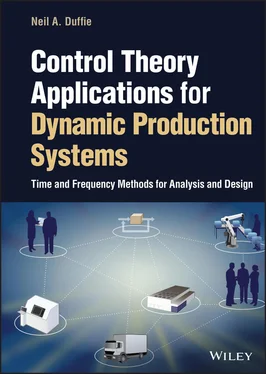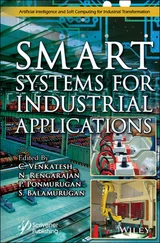13 7 Application Examples 7.1 Potential Impact of Digitalization on Improving Recovery Time in Replanning by Reducing Delays7.2 Adjustment of Steel Coil Deliveries in a Production Network with Inventory Information Sharing7.3 Effect of Order Flow Information Sharing on the Dynamic Behavior of a Production Network7.4 Adjustment of Cross-Trained and Permanent Worker Capacity7.5 Closed-Loop, Multi-Rate Production System with Different Adjustment Periods for WIP and Backlog Regulation7.6 SummaryReferences
14 Bibliography
15 Index
16 End User License Agreement
1 Chapter 1Figure 1.1 Replanning cycle with...Figure 1.2 Adjustment of permanent...Figure 1.3 Regulation of backlog...Figure 1.4 Adjustment of deliveries...Figure 1.5 Control of force...
2 Chapter 2Figure 2.1 Continuous variables in...Figure 2.2 Response of WIP...Figure 2.3 Backlog regulation in...Figure 2.4 Mixture outlet temperature...Figure 2.5 Experimental results obtained...Figure 2.6 Discrete variables in...Figure 2.7 Response of WIP...Figure 2.8 Discrete-time decision...Figure 2.9 Response of change...Figure 2.10 Exponential filter for...Figure 2.11 Response of desired...Figure 2.12 Lead time and...Figure 2.13 Adjustment of permanent...Figure 2.14 Linear approximation of...Figure 2.15 Production work system...Figure 2.16 Percent error in...Figure 2.17 Actual production capacity...
3 Chapter 3Figure 3.1 Unit step function...Figure 3.2 Exponential function with...Figure 3.3 Decaying sine function...Figure 3.4 Function with time...Figure 3.5 Mixture temperature regulation...Figure 3.6 Sequence...Figure 3.7 Ideal sampler with...Figure 3.8 Unit step sequence.Figure 3.9 Exponential sequence.Figure 3.10 Decaying sinusoidal sequence.Figure 3.11 Example of delayed...Figure 3.12 Continuous-time and...Figure 3.13 Summing and differencing...Figure 3.14 Block diagram for...Figure 3.15 Block diagram for...Figure 3.16 Transfer functions and...Figure 3.17 Result of combining...Figure 3.18 Transfer functions and...Figure 3.19 PID decision rule...Figure 3.20 Transfer functions in...Figure 3.21 Production system with...Figure 3.22 Block diagram for...Figure 3.23 Closed-loop transfer...Figure 3.24 Computer-controlled actuator...Figure 3.25 Block diagrams for...Figure 3.26 Block diagram for...Figure 3.27 Block diagrams showing...Figure 3.28 Pressing operation with...Figure 3.29 Equivalent block diagrams...Figure 3.30 Simplified block diagram...Figure 3.31 Block diagrams for...Figure 3.32 Closed-loop production...Figure 3.33 Warehouse with Product...Figure 3.34 Block diagram for...Figure 3.35 Block diagram for...Figure 3.36 Block diagram for...Figure 3.37 Zero-order hold...Figure 3.38 Discrete-time transfer...Figure 3.39 Block diagram with...Figure 3.40 Block diagram for...Figure 3.41 Replacement of zero...Figure 3.42 Production network with...
4 Chapter 4Figure 4.1 First-order continuous...Figure 4.2 Examples of second...Figure 4.3 Production system with...Figure 4.4 Examples of first...Figure 4.5 Examples of second...Figure 4.6 Production system with...Figure 4.7 Block diagram for...Figure 4.8 Block diagram for...Figure 4.9 Transient and steady...Figure 4.10 Response of continuous...Figure 4.11 Response of discrete...Figure 4.12 Response of actuator...Figure 4.13 Characteristics of step...Figure 4.14 Block diagram for...Figure 4.15 Response of mixture...Figure 4.16 Unit step response...
5 Chapter 5Figure 5.1 Example of transient...Figure 5.2 Example of response...Figure 5.3 Frequency response of...Figure 5.4 Bode plot of...Figure 5.5 Frequency response of...Figure 5.6 Production system with...Figure 5.7 Frequency response of...Figure 5.8 2nd-order continuous...Figure 5.9 Frequency response of...Figure 5.10 Frequency response of...Figure 5.11 Frequency response of...Figure 5.12 Frequence response of...Figure 5.13 Block diagram for...Figure 5.14 Frequency response of...Figure 5.15 Frequency response of...Figure 5.16 Frequency response of...Figure 5.17 Aliasing errors result...Figure 5.18 Aliasing errors in...Figure 5.19 Zero-frequency magnitude...Figure 5.20 Continuous-time or...Figure 5.21 Block diagrams for...Figure 5.22 Open-loop frequency...Figure 5.22 ( b ...
6 Chapter 6Figure 6.1 Closed-loop decision...Figure 6.2 Production system with...Figure 6.3 Block diagram for...Figure 6.4 Response to a...Figure 6.5 Step response with...Figure 6.6 Actuator with proportional...Figure 6.7 Step response with...Figure 6.8 Block diagram for...Figure 6.9 Response to step...Figure 6.10 Response to step...Figure 6.11 Proportional plus integral...Figure 6.12 Block diagram with...Figure 6.13 Response of backlog...Figure 6.14 Benchmark relationship between...Figure 6.15 Open-loop block...Figure 6.16 Open-loop frequency...Figure 6.17 Closed-loop error...Figure 6.18 Production system with...Figure 6.19 Open-loop frequency...Figure 6.20 Open-loop frequency...Figure 6.21 Closed-loop frequency...Figure 6.22 Block diagram for...Figure 6.23 Open-loop frequency...Figure 6.24 Open-loop frequency...Figure 6.25 Closed-loop mixture...Figure 6.26 PID control topologies...Figure 6.27 Decision-making divided...Figure 6.28 Block diagrams for...Figure 6.29 Response lead-time...Figure 6.30 Example of a...Figure 6.31 Example of discrete...Figure 6.32 Cascade computer control...Figure 6.33 Block diagram for...Figure 6.34 Cascaded discrete-time...Figure 6.35 Response of cascaded...Figure 6.36 Feedforward control. (a...Figure 6.37 Discrete-time regulation...Figure 6.38 Feedforward control added...Figure 6.39 Response of cascade...Figure 6.40 Discrete-time closed...Figure 6.41 Smith Predictor topology...Figure 6.42 Response to step...
7 Chapter 7Figure 7.1 Replanning cycle for...Figure 7.2 Block diagram of...Figure 7.3 Recovery time 4...Figure 7.4 Galvanizing lines share...Figure 7.5 Block diagram for...Figure 7.6 Variation in galvanizing...Figure 7.7 Amplitude of variation...Figure 7.8 Example of a...Figure 7.9 Block diagram for...Figure 7.10 Block diagram for...Figure 7.11 Change in WIP...Figure 7.12 Change in WIP...Figure 7.13 Case where 37...Figure 7.14 Change in WIP...Figure 7.15 Frequency range and...Figure 7.16 Block diagram for...Figure 7.17 Magnitude of frequency...Figure 7.18 Example of order...Figure 7.19 Example of order...Figure 7.20 Block diagram with...Figure 7.21 Sampler decomposition. (a...Figure 7.22 Response to a...Figure 7.23 Response to a...
1 Chapter 3 Table 3.1 Laplace transforms of common.... Table 3.2 Z transforms of common sequences.
2 Chapter 4Table 4.1 Settling times for various ratios...
3 Chapter 7Table 7.1 Improvement of recovery time...Table 7.2 Amplitude of variation of difference...Table 7.3 Summary of results for cases...
1 Cover
2 Title page
3 Copyright
4 Dedication
5 Table of Contents
6 Preface
7 Acknowledgments
8 Begin Reading
9 Bibliography
10 Index
11 End User License Agreement
1 i
2 ii
3 iii
4 iv
5 v
6 vi
7 vii
8 viii
9 ix
10 x
11 xi
12 xii
13 xiii
14 xiv
15 xv
16 xvi
17 1
18 2
19 3
20 4
21 5
22 6
23 7
24 8
25 9
26 10
27 11
28 12
29 13
30 14
31 15
32 16
33 17
34 18
35 19
36 20
37 21
38 22
39 23
40 24
41 25
42 26
43 27
44 28
45 29
46 30
47 31
48 32
49 33
50 34
51 35
52 36
53 37
54 38
55 39
56 40
57 41
58 42
59 43
60 44
61 45
62 46
63 47
64 48
65 49
Читать дальше












